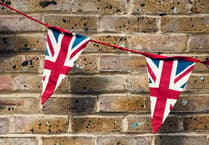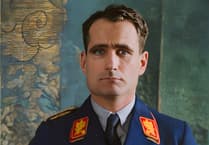Chepstow Quay, today a pleasant esplanade with jolly pubs, was wet and windy on the February dawn of 1840 when a prison van arrived with three chained prisoners escorted by mounted lancers. In Monmouth Gaol that morning the governor had informed them that their planned execution had been replaced by transportation for life.
A blue plaque in a quayside wall now reads: "From this riverside on 3rd February 1840, John Frost, William Jones and Zephaniah Williams, the convicted leaders of the Chartist March on Newport, sailed to begin their transportation to Van Diemen's Land (Tasmania)."
The paddle steamer Usk sailed to Avonmouth, then round Cornwall. In the terrible weather it took two weeks to reach Portsmouth – and a prison hulk. After a four month voyage, they went ashore in Hobart.
After various jobs around the island for the next 14 years, they were pardoned in 1854 – but not allowed to return home. William Jones died in Australia in 1873, Zephaniah Williams in Tasmania the following year.
But Frost risked an immediate return, sailing first to America. "The successful conclusion of the Crimean war in 1856 led to a grant of full pardons to political prisoners," writes David Harrison in his Monmouth and the Chartists booklet (£3). Supported by the Monmouth Field and History Society and Monmouth Archaeological Society it is available from bookshops and the museum.
"On 11th August 1856 Frost returned to Newport, the horses were removed from the flower decked carriage and he was drawn triumphant though the welcoming crowd. John Frost joined his wife in Stapleton, NE of Bristol. He lived until 1877, dying in his 93rd year."
*** ***
Next Wednesday evening in the graveyard of Newport's St. Woolos Cathedral, the annual gathering will take place at the memorial stone to remember the 22 men who died 170 years ago at the Westgate Hotel on this date in 1839.
"On the November 4, 1839 thousands of men from across South Wales marched on Newport," University of Wales academic Leslie James writes on the newport.ac.uk/chartist website. It includes details of other events in the 170th Anniversary Calendar of Chartist Events 2009-10 sponsored by the
University of Wales, Newport.
"Soldiers fired at the crowd that surrounded the Westgate Hotel. At least 22 men died in this protest to seek the vote for all men – and three of the leaders (John Frost, Zephaniah Williams and William Jones) were convicted of treason and exiled to Tasmania.
"Just after 9 o'clock on Monday morning 4th November, men from the hills of Gwent, mainly miners and iron workers, entered Newport. 5,000 strong, they marched in regular order down Stow Hill.
"Armed with picks, pikes and guns, they turned the corner and faced the Westgate Inn shouting 'Give us up the Prisoners'. Unseen from the street, soldiers of the 45th Regiment were only feet away inside the building.
"Lieutenant Gray ordered window shutters to be opened and led by Sergeant Daly, the 28 privates filed past the windows, firing their muskets in quick succession. This surprise tactic forced mass retreat [but] fighting lasted about 20 minutes.
"A correspondent counted 17 dead bodies. Samuel Homfray, ironmaster, reckoned there were 30. Ten bodies were buried in an unmarked grave at St Woolos churchyard on Thursday night, their names not entered in the burial register.
"Edward Dowling, editor of the Merlin, watched as 'Many who suffered in the fight crawled away; some exhibiting frightful wounds. Others, desperately maimed, were carried in the arms of the humane for medical aid.'
"Many of the wounded died later. Over 20 died that day, the precise number will never be known. Reporters from the Merlin and the Bristol Mercury believed that six men died at Caerleon and four others, who reached Tredegar.
"On no other occasion during the nineteenth or twentieth centuries has the military killed so many civilians in a single confrontation."
*** ***
The Chartists, here as elsewhere around Britain, were demanding political rights. All became commonplace (see panel), with additional extensions.
"Supporters of the People's Charter were disappointed that the 'Great Reform' Act of 1832 had granted the vote to only one in 10 of the adult male population, all owners of considerable property," Leslie James explains. "No constitutional reforms occurred during the time of the Chartist movement 1838-1850."
Supporters ranged from radical intelligentsia to working men (and women). Following the Newport confrontation, "large numbers were taken in for questioning and over 50 were charged with treason," says James.
"This draconian figure was reduced to 14 cases brought before the Special Assizes at Monmouth Shire Hall on 31st December, with a large number facing lesser charges. The trial of John Frost lasted eight days and with Frost found guilty by the jury, the trials of Zephaniah Williams and William Jones were swiftly dispatched."
The events in Monmouth have now been chronicled by local historian David Harrison. We met him earlier this year when he and the Friends of Monmouth Cemetery were launching the Monmouth Cemetery Trail leaflet.
He (and they) have now produced a second and similarly lavish Monmouth Town Chartist Trail, with support from the Monmouth Partnership Forum and Monmouthshire county council. Copies are available from the Monmouth One Stop Shop.
"This trail explores many of the old town buildings and locations with connections to the Chartists in Monmouth", David writes. Actually, it does a whole lot more – being effectively a comprehensive trail around the whole town centre.
It begins, naturally, at Shire Hall, seat of the assizes and the treason trial. The Charles Rolls statue celebrates a local hero, the aviator and motorist (1877-1910).
David points out that his grandfather J E W Rolls was one of the grand jury of local dignitaries initially considering the case in December. Rolls the Elder happily doodled his copy of the defendants list with sketches of Monmouth Gaol with gallows erected on its flat roof.
Unsurprisingly he and fellow magnates found a case to answer, and the trial proper – with more modest jurors – began on New Year's Eve. It was to be Britain's last mass treason trial.
It was not a kangaroo court, with prominent defending counsel and lasting a fortnight to January 16. This was somewhat longer than when the Dean forester Warren James and associates were tried and sentenced at the beginning of the decade.
Sensationally, the Lord Chief Justice summed up in favour of the defendants. Ignoring this, the jury took 30 minutes to find the accused guilty – though they did add a recommendation for mercy.
The execution date was fixed for the end of the month and carpenters began erecting the gallows. An appeal narrowly failed.
"The delay caused by the Judges' Hearing [on a technical legal point], however, was a significant factor in saving the lives of the prisoners." Petitions were lodged and the Chief Justice communicated with the Home Secretary – who recommended the application of the Royal Prerogative of mercy on February 1st.
The Trail describes the local papers, including the still flourishing Monmouthshire Beacon. Ironmonger James Hollings was the jury's only Monmouth town member.
Monmow Street's The Mason's Arms was a popular congregating place for Chartist supporters. They also met in what is today the Savoy Cinema and theatre.
The High Sheriff's chaplain preached in St Mary's Church that Chartism was on a level with nonconformity. Parade House was home of Charles Powell RN, one of the initial grand jury.
The County Gaol up the Hereford Road hill was managed with impressive consideration towards the prisoners by governor Charles Ford. The prison closed in 1867 with inmates transferred to the more central Usk.
"The main building was demolished in 1884," David notes. "Much of the stone was used to build Rock Cresscent [Monkswell Road) and Sharpness docks."
The trail ends at The White Swan Hotel where the Lancers were billeted during the trial. (David adds that the Assizes continued at the Shire Hall, its exterior currently being refurbished, for a full century till 1939.)
There were, as it turned out, no disturbances. Things were to be different in Merthyr Tydfil a few years after.
"The prisoners had little chance of a fair hearing and may rank in equal status with their unhappy bothers, the Tolpuddle Martyrs of 1834," David concludes.
Next Tuesday (November 3) at St Mary's RC Church at 7.30pm David Harrison will be elaborating on the "Monmouth and the Chartists" story in an illustrated lecture (tickets £2) organised under the auspices of the CAMEO group.
The People's Charter demanded:
1: All men over age of 21 to have the right to vote
2: 300 electoral constituencies of equal size
3: Secret voting
4: Abolition of property qualification for MPs
5: Payment of a wage to MPs
6: Annual elections to Parliament




